
The Bottom Line
Introduction, Drive Specifications, Pricing and Availability
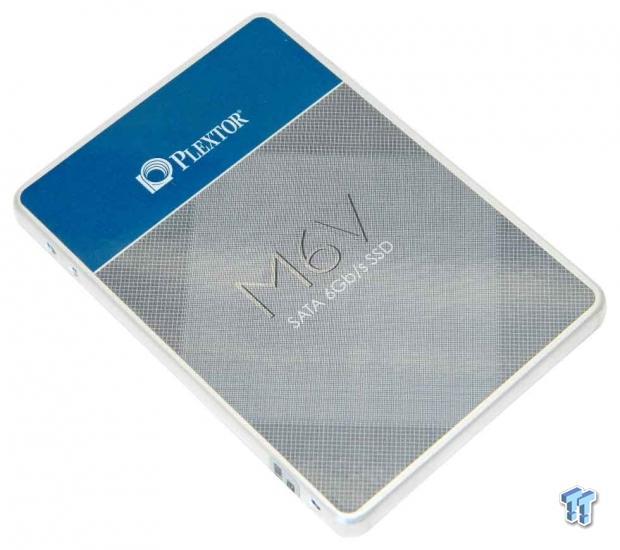
The Plextor M6V is another option in a vast landscape of value drives powered by Silicon Motion's powerful little SM2246EN 4-channel SSD controller. The M6V is the first SSD we've tested that is utilizing Toshiba's new 15nm MLC synchronous toggle flash. SM2246EN powered SSDs have quickly become de facto products in the value segment. Drives powered by this highly popular controller are well known for great performance, low power consumption and low cost.
Plextor is a well-respected brand, well known for delivering quality and high performing SSDs. Until now, Plextor SSD's have been powered by Marvell controllers with custom firmware written in-house by Plextor's firmware team. Writing custom firmware allows Plextor to separate themselves from competing solutions that utilize canned firmware. The M6V is the first non-Marvell controlled Plextor SSD we've tested. As with their Marvell powered SSDs, the M6V employ's exclusive custom firmware written in-house by Plextor's firmware team.
Custom firmware and new 15nm Toshiba MLC flash is a break from the norm and has us intrigued. To further distinguish the M6V from the rest of the field, Plextor offers their exclusive PlexTurbo caching software to M6V owners. PlexTurbo accelerates read/write performance of the M6V dramatically while at the same time boosting the service life of the M6V by caching small random writes and writing them sequentially to the drive's flash array. The M6V is Plextor's mid-level performer, and they have limited the amount of caching available to the M6V to 1GB of system DRAM. We would like a little more, but as you will see even when limited to 1GB caching, PlexTurbo is quite effective.
The M6V is currently retailing for $99.99 at Amazon. The drive is competitively priced, and in fact, is priced the same as many TLC flash based SSDs. We are going to pit the M6V against similarly configured SM2246EN powered drives; does Plextor's combination of custom firmware and 15nm MLC Toshiba flash have what it takes to outperform the competition? Let's take a close look.
Specifications: Plextor M6V 256GB SATA III SSD
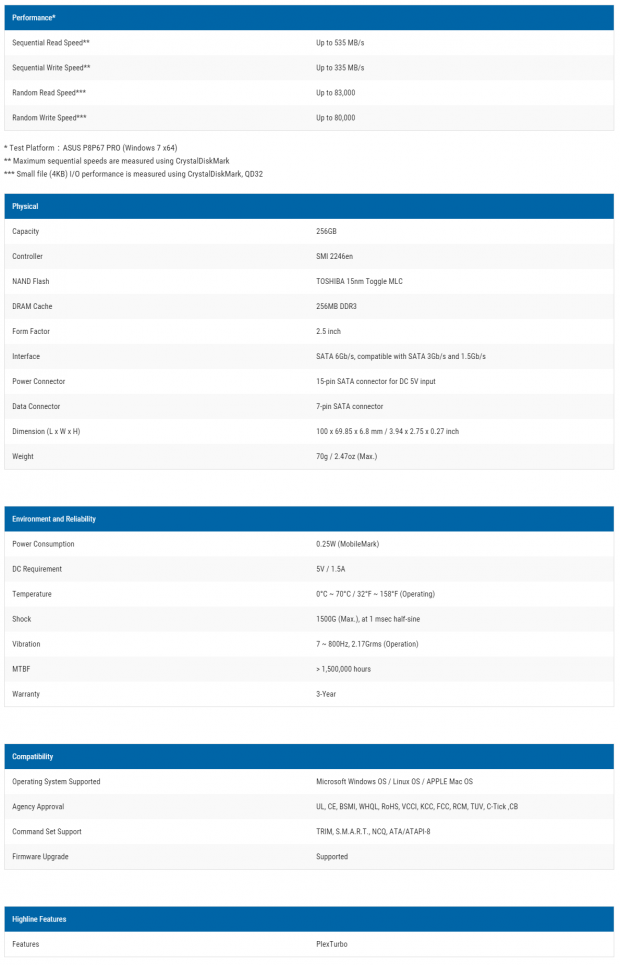
The M6V SATA III 2.5" x 7mm FF SSD is available in three capacities: 128GB, 256GB and 512GB. Sequential read performance for the M6V is listed as up to 535 MB/s. Sequential write performance varies by capacity from 170 MB/s up to 460 MB/s. Random 4K read performance varies by capacity from 81,000 up to 83,000 IOPS. Random 4K write performance varies by capacity from 42,000 up to 80,000 IOPS. MTBF comes in at 1.5 million hours. Plextor backs the M6V with an industry standard 3-year warranty. No TBW is given.
Drive Details
Plextor M6V 256GB SATA III SSD
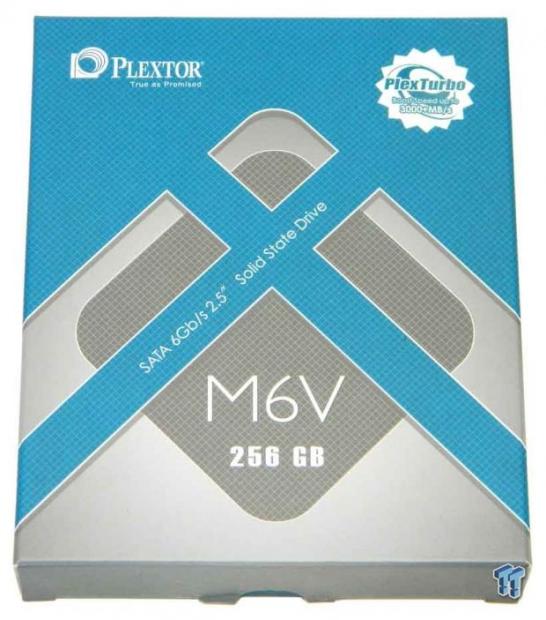
The M6V retails in small blue and grey box that has a grid pattern on it. On the upper right corner of the box, there is a small advertisement of the drive's compatibility with PlexTurbo acceleration software.
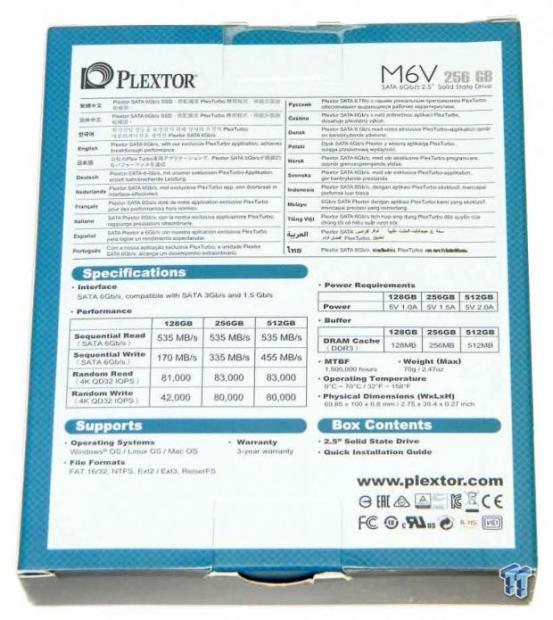
The rear of the packaging lists the drives performance capabilities at each capacity point. The drives power consumption and DRAM cache capacities are also given.
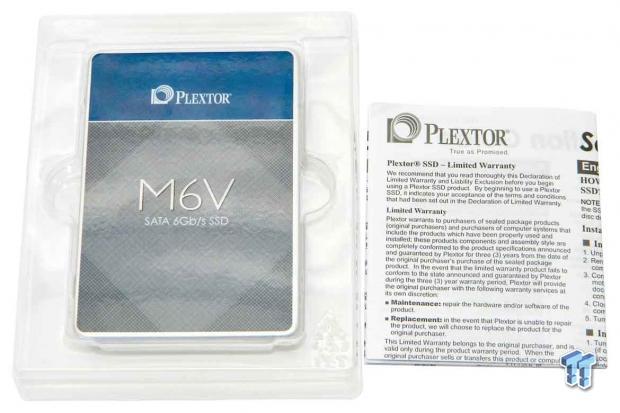
Inside the box, we find the drive itself protected within a clear plastic tray. Also included is a paper warranty and installation guide.

The front of the drives aluminum enclosure is covered with an attractive blue and grey manufacturer's label.
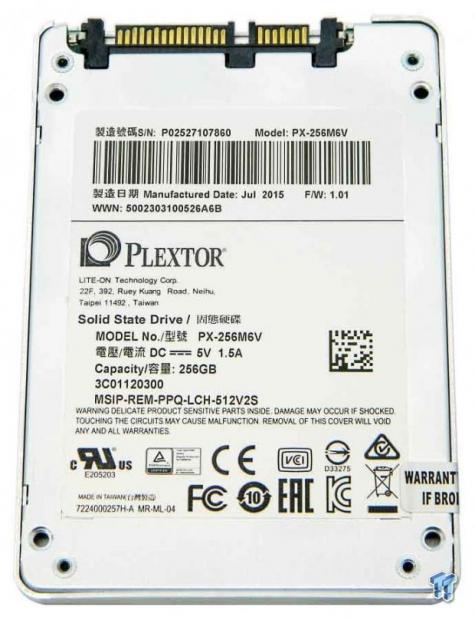
The back half of the drives aluminum enclosure has another manufacturer's label that lists the drives model number, serial number, shipping firmware and other relevant information.

The drives full-length PCB is attached to the bottom of the drives aluminum enclosure with four screws.


The drives SM2246EN controller, eight flash packages, and DRAM cache package are located on this side of the full-length PCB. Plextor employs a thermal pad to wick heat from the drives controller. We like this feature; it's something we don't always get from an SM2246EN controlled SSD.
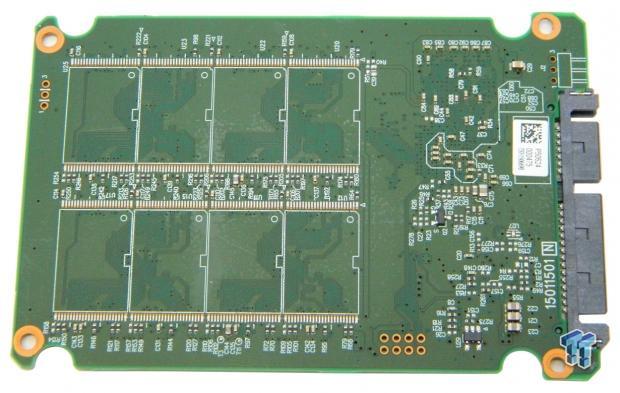
This side of the PCB is devoid of major components.

A close-in view of the 4-channel Silicon Motion SM2246EN controller that powers the M6V.

A close-in view of the drives eight, 15nm 128Gb die 32GB TSOP flash packages.

Finally, a close-in view of the drives 256MB SK Hynix DRAM package.
Test System Setup and Properties
Jon's Consumer SSD Review Test System Specifications
- Motherboard: ASRock Extreme9 Z97 - Buy from Amazon
- CPU: Intel Core i7 4790K @ 4.8GHz - Buy from Amazon / Read our review
- Cooler: Swiftech H2O-320 Edge - Buy from Amazon / Read our review
- Memory: Corsair Dominator DDR3 32GB 2400MHz - Buy from Amazon
- Video Card: Onboard Video
- Case: IN WIN X-Frame - Buy from Amazon / Read our review
- Power Supply: Seasonic Platinum 1000 Watt Modular - Buy from Amazon / Read our review
- OS: Microsoft Windows 10 Professional 64-bit - Buy from Amazon
- Drivers: Intel RAID option ROM version 13.0.0.2075 and Intel RST driver version 13.6.0.1002
We would like to thank ASRock, Crucial, Intel, Corsair, RamCity, IN WIN, and Seasonic for making our test system possible.
Drive Properties
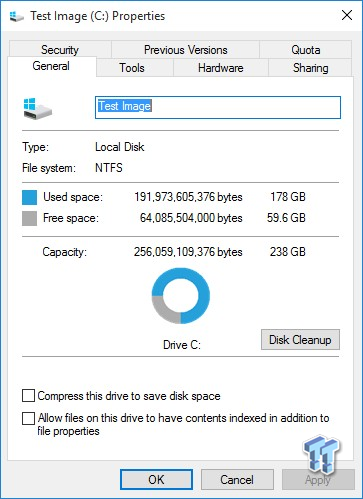
The majority of our testing is performed with our test drive as our boot volume. Our boot volume is 75% full for all OS Disk "C" drive testing to replicate a typical consumer OS volume implementation. We feel that most of you will be utilizing your SSD's for your boot volume and that presenting you with results from an OS volume is more relevant than presenting you with empty secondary volume results.
System settings: Cstates and Speed stepping are both disabled in our systems BIOS. Windows High Performance power plan is enabled. Windows write caching is enabled, and Windows buffer flushing is disabled. We are utilizing Windows 10 Pro 64-bit OS for all of our testing except for our MOP (Maxed-Out Performance) benchmarks where we switch to Windows Server 2008 R2 64 Bit.
Synthetic Benchmarks - ATTO & Anvil Storage Utilities
ATTO
Version and / or Patch Used: 2.47
ATTO is a timeless benchmark used to provide manufacturers with data used for marketing storage products.
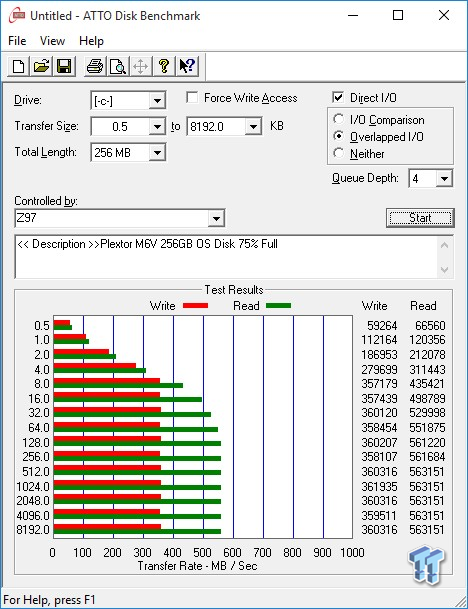
Sequential read/write transfers max out at 563/360 MB/s. Keep in mind this is our OS volume 75% full.
Sequential Write

The sequential write performance of the M6V is easily exceeding Plextor's specification of 335 MB/s. The other drives on our chart are all higher capacity, and all have higher sequential transfer performance.
Sequential Read

The M6V outperforms the competition with small transfers up to 2KB. Overall, the OCZ Trion wins, but the M6V is outperforming the rest of the test pool of similarly configured SM2246EN powered SSDs, despite their larger capacities.
Anvil Storage Utilities
Version and / or Patch Used: 1.1.0
Anvil's Storage Utilities is a storage benchmark designed to measure the storage performance of SSD's. The Standard Storage Benchmark performs a series of tests; you can run a full test or just the read or write test, or you can run a single test, i.e. 4k QD16.

Scoring
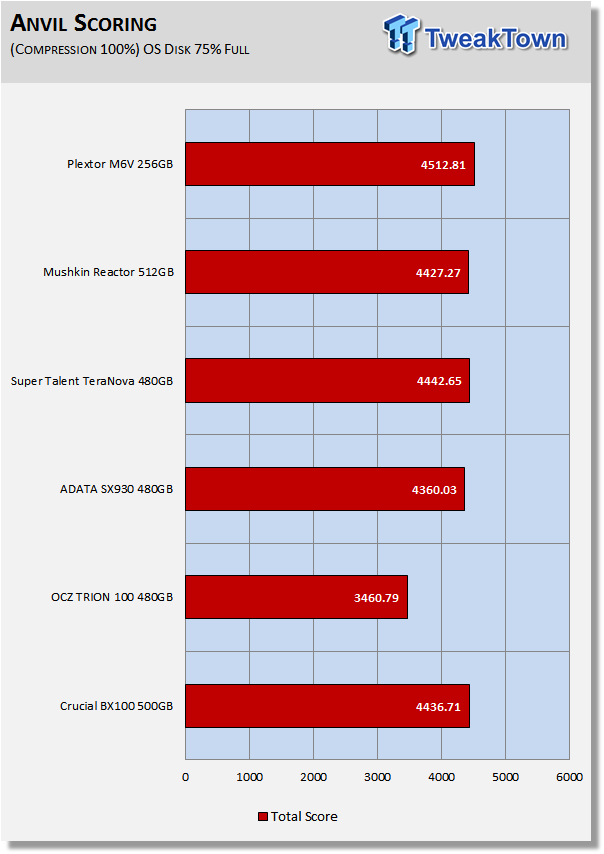
Anvil's scoring gives a good indication of a drive's overall performance. The M6V delivers the best overall score of the drives in our test pool. This is our first indication that 15nm Toshiba flash can deliver the goods.
(Anvil) Read IOPS through Queue Depth Scale

At lower queue depths, the M6V is delivering superior performance. At higher queue depths, the Trion wins out.
(Anvil) Write IOPS through Queue Scale

This is a clear win for the M6V. Plextor's custom firmware and Toshiba 15nm flash win out in this test.
Synthetic Benchmarks - CrystalDiskMark & AS SSD
CrystalDiskMark
Version and / or Patch Used: 3.0 Technical Preview
CrystalDiskMark is disk benchmark software that allows us to benchmark 4k and 4k queue depths with accuracy. Note: Crystal Disk Mark 3.0 Technical Preview was used for these tests since it offers the ability to measure native command queuing at QD4.


I want to point out the M6V's 4K and 4K QD4 performance because it's significantly better than the rest of our test pool.

Our M6V test unit is only 256GB, so it's no surprise that it doesn't have as high of sequential transfer rates as the rest of the larger capacity drives. The M6V does deliver the best QD32 performance of the bunch.
AS SSD
Version and / or Patch Used: 1.7.4739.38088
AS SSD determines the performance of Solid-State Drives (SSD). The tool contains four synthetic as well as three practice tests. The synthetic tests are to determine the sequential and random read and write performance of the SSD.

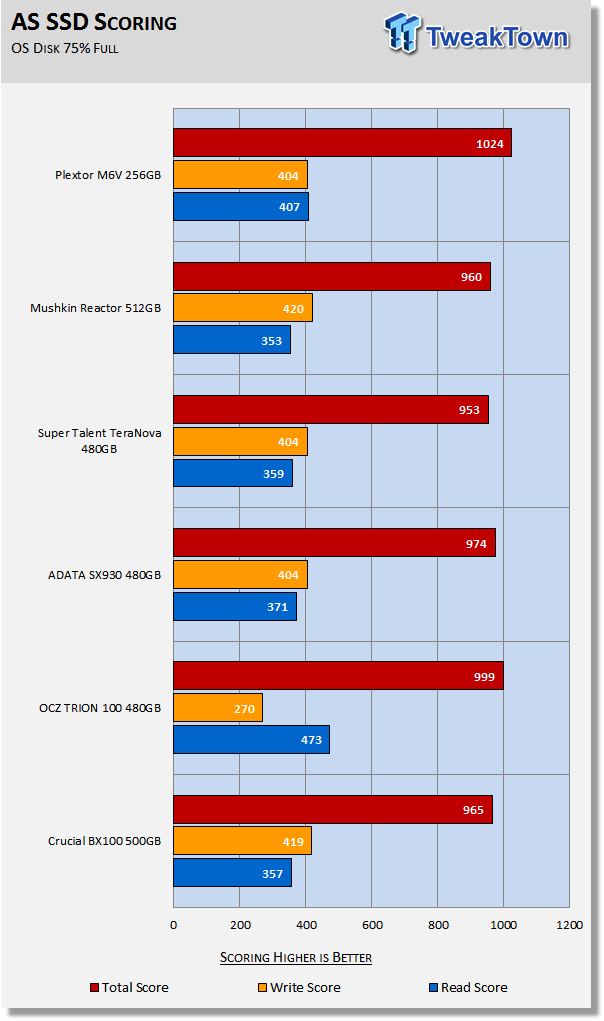
All of the SM2246EN controlled drives score about the same except the M6V. The M6V is the clear winner of this test with a significantly better score than the rest of the drives on our chart. This is despite having the lowest sequential performance.
Benchmarks (Trace Based OS Volume) - PCMark Vantage, PCMark 7 & PCMark 8
Moderate Workload Model
We categorize these tests as indicative of a moderate workload environment.
PCMark Vantage - Hard Disk Tests
Version and / or Patch Used: 1.2.0.0
The reason we like PCMark Vantage is because the recorded traces are played back without system stops. What we see is the raw performance of the drive. This allows us to see a marked difference between scoring that other trace-based benchmarks do not exhibit. An example of a marked difference in scoring on the same drive would be empty vs. filled vs. steady state.
We run Vantage three ways. The first run is with the OS drive 75% full to simulate a lightly used OS volume filled with data to an amount we feel is common for most users. The second run is with the OS volume written into a "Steady State" utilizing SNIA's guidelines. Steady state testing simulates a drives performance similar to that of a drive that been subjected to consumer workloads for extensive amounts of time. The third run is a Vantage HDD test with the test drive attached as an empty, lightly used secondary device.
OS Volume 75% Full - Lightly Used

OS Volume 75% Full - Steady State

Secondary Volume Empty - FOB

There's a big difference between an empty drive, one that's 75% full/used, and one that's in a steady state.

The important scores to pay attention to are "OS Volume Steady State" and "OS Volume 75% full." These two categories are most important because they are indicative of typical of consumer user states. When a drive is in a steady state, it means garbage collection is running at the same time it's reading/writing. This is exactly why we focus on steady state performance.
At 75% full and lightly used, the M6V delivers the best score of our test pool. Empty secondary scoring is almost meaningless, so let's focus on steady state performance. The ADATA SX930 with its binned flash and PSLC caching layer delivers slightly better steady state performance, but the M6V outperforms the other SM2246EN powered SSDs.
PCMark 7 - System Storage
Version and / or Patch Used: 1.4.0
We will look to Raw System Storage scoring for evaluation because it's done without system stops and, therefore, allows us to see significant scoring differences between drives.
OS Volume 75% Full - Lightly Used


Another win for the M6V. It outperforms the rest of the test pool delivering an excellent score of 6,799.
PCMark 8 - Storage Bandwidth
Version and / or Patch Used: 2.4.304
We use PCMark 8 Storage benchmark to test the performance of SSDs, HDDs, and hybrid drives with traces recorded from Adobe Creative Suite, Microsoft Office, and a selection of popular games. You can test the system drive or any other recognized storage device, including local external drives. Unlike synthetic storage tests, the PCMark 8 Storage benchmark highlights real-world performance differences between storage devices.
OS Volume 75% Full - Lightly Used

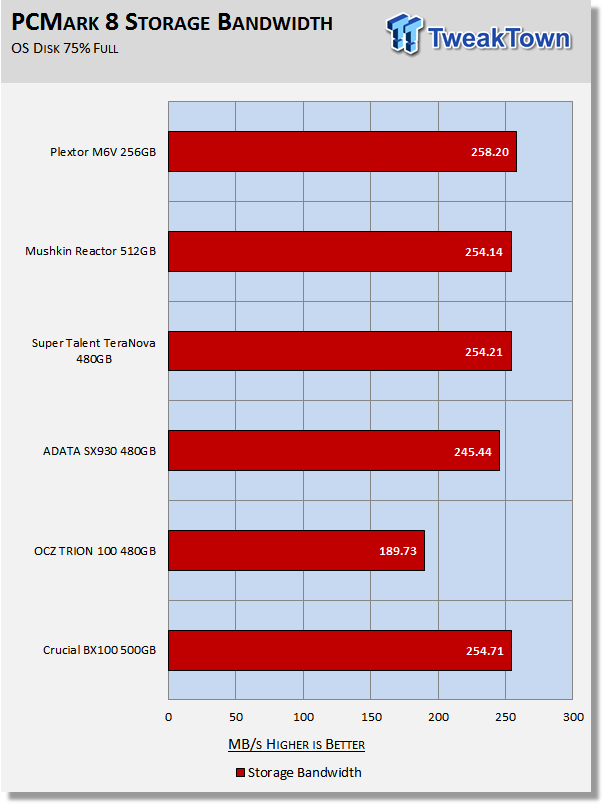
PCMark 8 is the most intensive moderate workload simulation we run. With regard to moderate workloads, this test is what we consider the best indicator of a drives performance. Another win for the M6V. Despite its capacity handicap and lower sequential write performance, the M6V delivers better performance than the competition.
Benchmarks (Secondary Volume) - Max IOPS, Disk Response & Transfer Rates
Iometer - Maximum IOPS
Version and / or Patch Used: Iometer 2014
We use Iometer to measure high queue depth performance. (No Partition)
Max IOPS Read

Max IOPS Write


Plextor's specified 83,000 read IOPS for the Reactor is obviously a conservative figure, as we easily exceed specification by over 10K. We are dead on hitting the drives specified 80K write IOPS. 80K IOPS is by far the best random write performance of the drives in our test pool. 15nm Toshiba MLC is looking very good.
Iometer - Disk Response
Version and / or Patch Used: Iometer 2014
We use Iometer to measure disk response times. Disk response times are measured at an industry accepted standard of 4K QD1 for both write and read. Each test runs twice for 30 seconds consecutively, with a 5-second ramp-up before each test. We partition the drive/array as a secondary device for this testing.
Avg. Write Response

Avg. Read Response


Write response times are middle of the pack. However, read response times are again another win for the M6V.
DiskBench - Directory Copy
Version and / or Patch Used: 2.6.2.0
We use DiskBench to time a 28.6GB block (9,882 files in 1,247 folders) composed primarily of incompressible sequential and random data as it's transferred from our DC P3700 PCIe NVME SSD to our test drive. We then read from a 6GB zip file that's part of our 28.6GB data block to determine the test drives read transfer rate. Our system is restarted before the read test to clear any cached data, ensuring an accurate test result.
Write Transfer Rate

Read Transfer Rate


We are starting to see a trend here. The M6V is winning all or a good portion of nearly every test so far. As expected, the M6V has a lower write transfer rate than the larger capacity drives with the exception of the TLC powered Trion. The M6V delivers the best read transfer rate of the drives on our chart.
Benchmarks (Secondary Volume) - PCMark 8 Extended
Futuremark PCMark 8 Extended
Heavy Workload Model
PCMark 8's consistency test simulates an extended duration heavy workload environment. PCMark 8 has built-in, command line executed storage testing. The PCMark 8 Consistency test measures the performance consistency and the degradation tendency of a storage system.
The Storage test workloads are repeated. Between each repetition, the storage system is bombarded with a usage that causes degraded drive performance. In the first part of the test, the cycle continues until a steady degraded level of performance has been reached. (Steady State)
In the second part, the recovery of the system is tested by allowing the system to idle and measuring the performance after 5-minute long intervals. (Internal drive maintenance: Garbage Collection (GC)) The test reports the performance level at the start, the degraded steady-state, and the recovered state, as well as the number of iterations required to reach the degraded state and the recovered state.
We feel Futuremark's Consistency Test is the best test ever devised to show the true performance of solid-state storage in an extended duration heavy workload environment. This test takes on average 13 to 17 hours to complete and writes somewhere between 450GB and 14,000GB of test data depending on the drive. If you want to know what an SSD's steady state performance is going to look like during a heavy workload, this test will show you.
Here's a breakdown of Futuremark's Consistency Test:
Precondition phase:
1. Write to the drive sequentially through up to the reported capacity with random data.
2. Write the drive through a second time (to take care of overprovisioning).
Degradation phase:
1. Run writes of random size between 8*512 and 2048*512 bytes on random offsets for 10 minutes.
2. Run performance test (one pass only).
3. Repeat 1 and 2 for 8 times, and on each pass increase the duration of random writes by 5 minutes.
Steady state phase:
1. Run writes of random size between 8*512 and 2048*512 bytes on random offsets for 50 minutes.
2. Run performance test (one pass only).
3. Repeat 1 and 2 for 5 times.
Recovery phase:
1. Idle for 5 minutes.
2. Run performance test (one pass only).
3. Repeat 1 and 2 for 5 times.
Storage Bandwidth
PCMark 8's Consistency test provides a ton of data output that we use to judge a drive's performance.

We consider steady state bandwidth (the blue bar) our test that carries the most weight in ranking a drive/arrays heavy workload performance. Performance after Garbage Collection (GC) (the orange and red bars) is what we consider the second most important consideration when ranking a drives performance. Trace-based steady state testing is where true high performing SSDs are separated from the rest of the pack.
In a steady state, the M6V is once again the clear winner. After one and five 5 minute intervals of garbage collection, the SX930 with its PSLC layer delivers higher performance, but we are going to call this another win for the M6V.

We chart our test subject's storage bandwidth as reported at each of the test's 18 trace iterations. This gives us a good visual perspective of how our test subjects perform as testing progresses. The M6V delivers by far the best degrade and steady state performance of the drives in our test pool.
Total Access Time (Latency)
We chart the total time the disk is accessed as reported at each of the test's 18 trace iterations.

Disk Busy Time
Disk Busy Time is how long the disk is busy working. We chart the total time the disk is working as reported at each of the tests 18 trace iterations.

When latency is low, disk busy time is low as well.
Data Written
We measure the total amount of random data that our test drive/array is capable of writing during the degradation phases of the consistency test. Pre-conditioning data is not included in the total. The total combined time that degradation data is written to the drive/array is 470 minutes. This can be very telling. The better a drive/array can process a continuous stream of random data, the more data will be written.

Combined read/write latency, capacity and overprovisioning are the biggest factors that determine the outcome of this portion of the test. The M6V's lower capacity and lack of OP puts it at a disadvantage in this test.
Benchmarks (Secondary Volume) - 70/30 Mixed Workload
70/30 Mixed Workload Test (Sledgehammer)
Version and / or Patch Used: Iometer 2014
Heavy Workload Model
This test hammers a drive so hard we've dubbed it "Sledgehammer". Our 70/30 Mixed Workload test is designed to simulate a heavy-duty enthusiast/workstation steady-state environment. We feel that a mix of 70% read/30% write, full random 4K transfers best represents this type of user environment. Our test allows us to see the drive enter into and reach a steady state as the test progresses.
Phase one of the test preconditions the drive for 1 hour with 128K sequential writes. Phase two of the test runs a 70% read/30% write, full random 4K transfer workload on the drive for 1 hour. We log and chart (phase two) IOPS data at 5-second intervals for 1 hour (720 data points). 60 data points = 5 minutes.

What we like about this test is that it reflects reality. Everything lines up, as it should. Consumer drives don't outperform Enterprise-Class SSD's that were designed for enterprise workloads. Consumer drives based on old technology are not outperforming modern Performance-Class SSD's, etc.
Lack of OP is handicapping the M6V in this brutal test. The TeraNova and the SX930 both have a healthy dose of OP, and that makes a huge difference in this enterprise-class test. Even a little OP makes a big difference as evidenced by the BX100. The Reactor like the M6V has zero OP. The Trion is choking to death on TLC Flash even with plenty of OP.
Maxed-Out Performance (MOP)
This testing is just to see what the drive is capable of in an FOB (Fresh Out of Box) state under optimal conditions. We are utilizing Windows Server 2008 R2 64-bit for this testing. Same Hardware, just an OS change.




PlexTurbo Performance Windows 10



PlexTurbo is performing as advertised, delivering a nice performance boost for transfers up to 1GiB.
Final Thoughts

We threw the 256GB Plextor M6V into the fire with larger capacity drives half expecting it to get burned. We didn't expect to find the M6V would outperform the larger capacity drives, many powered by the same controller, but that's what happened. The M6V is the first SSD we've tested that's powered by Toshiba 15nm MLC toggle flash, and we are pleasantly surprised by how well it performs.
Comparing the M6V to the BX100 and the Reactor, it is pretty clear that 15nm Toshiba MLC flash outperforms 16nm Micron MLC flash. We like Plextor's choice of flash, and their custom firmware seems to give it an edge over much of the competition. PlexTurbo is a nice value add that delivers a significant performance boost and increases flash endurance.
Plextor's M6V is not just another SM2246EN powered SSD. Overall, it's the best performing SM2246EN powered drive we've tested to date. Keep in mind that the 512GB capacity M6V will have even better performance. With SSDs trending toward TLC flash, the Plextor M6V is a low-cost alternative powered by quality MLC flash making it one of the better drives on the market today.
Plextor's M6V is TweakTown recommended.
Pros:
- Quality 15nm Toshiba MLC Toggle Flash
- PlexTurbo
- Full 256GB Capacity
Cons:
- No accessories
- Sequential Write Speed

| Performance | 90% |
| Quality including Design and Build | 85% |
| General Features | 85% |
| Bundle and Packaging | 85% |
| Value for Money | 95% |
| Overall | 88% |
The Bottom Line: If you are looking for a low-cost SSD with MLC flash, the M6V is a nice option that has a little more under the hood than most of the competition.
PRICING: You can find products similar to this one for sale below.
 United
States: Find other tech and computer products like this
over at Amazon.com
United
States: Find other tech and computer products like this
over at Amazon.com
 United
Kingdom: Find other tech and computer products like this
over at Amazon.co.uk
United
Kingdom: Find other tech and computer products like this
over at Amazon.co.uk
 Australia:
Find other tech and computer products like this over at Amazon.com.au
Australia:
Find other tech and computer products like this over at Amazon.com.au
 Canada:
Find other tech and computer products like this over at Amazon.ca
Canada:
Find other tech and computer products like this over at Amazon.ca
 Deutschland:
Finde andere Technik- und Computerprodukte wie dieses auf Amazon.de
Deutschland:
Finde andere Technik- und Computerprodukte wie dieses auf Amazon.de
What's in Jon's PC?
- CPU: AMD Ryzen 7800X 3D
- MOTHERBOARD: GIGABYTE AORUS Master X670E
- RAM: Kingston Fury Renegade 7200MHz 32GB
- GPU: ZOTAC AMP Extreme GeForce RTX 4090
- SSD: Crucial T700 2TB Gen5
- OS: Windows 11 Pro
- COOLER: Lian Li Galahad 360 AIO
- CASE: Lian Li Lancool III
- KEYBOARD: Corsair K65 RGB Mini
- MOUSE: SteelSeries AEROX 5 Wireless
- MONITOR: ASUS ROG Strix PG27AQN 360Hz 1440p ULMB2
Similar Content
Related Tags

